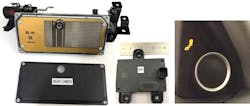What you will learn:
• "ADAS" describes a group of systems providing driver assist
• Not every vehicle will be equipped with all ADAS systems
• No present DTCs doesn't mean the ADAS systems are properly calibrated
Is your collision repair shop "radar-ready?" ADAS (Advanced Driver Assistance Systems) uses sensors that function by way of radar (radio waves), lidar (light waves), and ultrasonic (sound waves) technologies. ADAS can also afford the driver a “second set of eyes" while driving forward, backing up, or seeing what's in the adjacent lanes with the use of smart cameras. ADAS is designed to prevent accidents, or at least reduce their severity. But what happens when an accident does occur, and these amazing sensors and cameras are damaged or misaligned? Will they simply turn on a warning light/set a DTC if something is wrong after the collision repair? Are a pre- and post-scan all you need to decide to call in the mobile diagnostic techs (or flatbed to the OEM car dealer)? The answers to these questions and many more can be as complicated as ADAS technology itself. But there are comprehensible answers to those questions that we will cover in this series of two ADAS articles.
I must admit, I grew up as a repair tech in my parents’ auto electric shop. That makes me an outsider to the collision repair/paint world. My career transitioned to the very high-tech world of automotive electronics when I joined Delco Electronics (a division of General Motors) over three decades ago. I spent a lot of time in a research garage watching, helping, and learning from engineers who invented some of the first technologies that would eventually be called ADAS (Advanced Driver Assistance Systems). Working as a systems trainer and technical support line advisor, I’ve learned to “translate” the descriptions of how electronics systems work into terms repair technicians can relate to. In “Radar Ready Part 1”, we’ll explain what you need to know regarding ADAS theory before you perform a pre-scan. In part 2 (May 2022 issue) we’ll share tips on the repair procedures and post-scan variables on today's ADAS-equipped vehicles.
The nuts, bolts, buses, and sensors of ADAS
Nuts and bolts – we all know those terms. I refer to “buses” as the low, medium, and high-speed Controller Area Network (CAN) communications circuits (often two-wire twisted pair wiring) and other data protocols for modules to communicate with each other and with your diagnostic equipment. The “sensors” are the actual ADAS components. Radars, cameras, and (more recently) Lidars are the components that come to mind when we think of ADAS, but it doesn’t end there. We must include ultrasonic (sometimes called “sonar” by some OEMs) and system interactions (brakes, throttle, steering) in our understanding of ADAS. Engineers began using the "ADAS Level" number assignments several years ago.
Level 0: No Automation/no ADAS (i.e., your “father’s Oldsmobile”)
Level 1: Driver Assistance (one ADAS system i.e., adaptive cruise control)
Level 2: Partial Automation (two or more ADAS systems i.e., lane keep assist and adaptive cruise control)
Level 2+: Advanced Partial Automation (two or more ADAS systems but the driver must be ready to take control)
Level 3: Conditional Automation (multiple ADAS systems allowing the driver to not interact if correct conditions are present (road surfaces/locations, weather, vehicle speed, etc)
Level 4: High Automation (multiple ADAS systems as in level 3 but the system will alert the driver if conditions require human intervention
Level 5: Full Automation (level 4 w/o any controls for the driver to interact with)
Radar sensors - Radio detection and ranging
ADAS radar sensors send out high-frequency radio signals that are reflected off surfaces (targets) bouncing back to the source. The very short delay in the bounced back radio signal is used to determine the distance between the sensor (vehicle) and the target (another vehicle). The frequency is often referred to as “millimeter radar” and ranges from 24 GHz up to 81 GHz. Automotive radar sensors used to be electromechanical . . . like a smaller version of what you see on top of a ship or airport control tower, the antenna moved within the radar housing. The older ADAS radar sensors only rotated (back and forth) a few degrees to determine the distance to a target in front of the vehicle. These early models were large, often had objectionable mechanical noise when operating (from the internal rotating gimble) and were expensive. ESR (electronically scanning radar) using advanced solid-state technologies brought down the price and size as they evolved with multiple radar antenna “beams,” electronically scanning back and forth across their target zones. (Fig. 1, left and center)
IMPERFECT TECHNOLOGY TECH TIP: Blind spot monitor radar sensors can sometimes trigger for no apparent reason (false-positive alert) when the vehicle drives past stationary objects (fences, mailboxes, etc.). They can also miss rapidly approaching vehicles in an adjacent lane (false negative – no alert). Long-range radar sensors used in adaptive cruise control may not always notice a stationary object (another vehicle stopped directly in front of an ADAS vehicle) (Figure.1, center and right). Even with the higher radar frequencies / Doppler radar technologies, eliminating both types of errors is mainly the job of the vehicle manufacturer’s software. However, improper collision repair-related sensor alignment (calibration) and paint can cause these errors, too.
Digital (Smart) Camera Sensors
To start, I’ll differentiate between analog and digital cameras. Analog cameras are commonly used in backup aid systems. Digital cameras communicate what they are “seeing” on the CAN bus. Newer vehicles may break the CAN bus into several separate buses connected to a common gateway module. Like the human eye looking through smudged eyeglasses, these “smart” digital ADAS camera sensors can experience performance limitations caused by everything from poor visibility (weather conditions), improper windshield design/quality, and even bugs/dirt on the windshield. More tips on diagnostic and calibration procedures for both camera and radar sensors are forthcoming in “Radar Ready Part 2.”
Lidar sensors – light detection and ranging
These sensors can sometimes do the job of both radar and camera sensors, although radar is still superior for certain limited visibility conditions such as night driving. However, ADAS radar sensors can't “see through” heavy snow and rain due to the reflective nature of the elements on this type of radar. Like law enforcement laser speed detection, ADAS Lidar sends out infrared (invisible to the human eye) laser (light) beams. ADAS lidar differs from police lidar in that it’s not a single narrow focus (18-36 inches at 1,000 feet) beam for single-vehicle speed detection. ADAS lidar uses a continuous multidirectional sweep of between 8 and 128 infrared laser beams to create a computerized “3D contour map” (a.k.a. 3D Point Cloud). Lidar technology used in navigation mapping can be leveraged to create precision navigation electronic “road maps” (used by GM vehicles with Super Cruise). GM Super Cruise vehicles do NOT currently use actual lidar sensors. Lidar sensors on other vehicles, however, give automotive ADAS systems superior computerized views (compared to cameras) of the vehicle’s surroundings along with distances (and speeds) of vehicles and objects in proximity to the lidar-equipped vehicle.
Until recently, lidar was electromechanical. The sensor constantly rotated a mirror to scan the surroundings with an infrared laser. This made packaging, styling, and placement difficult. They reminded me of a large spinning “soup can” on top of the roof (Figure 2, left). Even with the evolution of lower-cost solid-state lidar sensors (Fig. 2 right), all ADAS sensors continue to have their advantages over each other. This means you'll likely see a variety of ADAS sensor technologies including the ‘big three’ listed below, along with ultrasonic / sonar (parking) sensors and infrared night vision on the vehicles coming into your collision repair shop.
Blurred lines? A humorous case study
A couple of years ago Rick (a fellow automotive instructor) texted me during his vacation trip while in a rental car equipped with a full array of ADAS features. On the vehicle’s DIC (Driver Information Center) in the center of the cluster, Rick was observing the message “Blurred Lines.” He was curious what the cause of this “warning” message might be. We texted back and forth brainstorming the cause. Could it be caused by road lane marker paint defects, a poor-quality aftermarket windshield, a defective camera, or simply a dirty windshield? I've seen Toyota factory scan tool data PIDs showing "Thick Lines / Thin Lines" as lane marker camera detection status values. Maybe this vehicle was showing something similar on the DIC? The answer was “none of the above,” and it was Rick’s wife, Pat who solved the mystery. There was no ADAS problem at all. She observed that the “warning message” on the DIC was also on the radio’s display. But the radio was more detailed - showing the title of a hit song by singer Robin Thicke – “Blurred Lines” (Figure 3, left). The previous renter had left some mp3 music files in the vehicle! Rick and I still laugh at ourselves over that one. A lack of knowledge regarding ADAS can be a safety issue to our customers, so please take this topic seriously. But we shouldn’t take ourselves too seriously! After all, we’re all perpetual students when it comes to becoming “Radar Ready” on today’s vehicles! (Figure 3, center and right)
About the Author
Dave Hobbs
Dave Hobbs is a senior technical trainer and curriculum developer for Delphi Technologies Aftermarket at BorgWarner Inc. He's Master ASE-certified with L1 (advanced engine performance) & L3 (hybrid) specialist certifications.
He has extensive OEM service and field engineering expertise, with more than 30 years of experience in troubleshooting vehicle systems electronics, with 15 of those years in the independent aftermarket repair business. He has 20 years of experience in training engineers (worldwide) and service technicians in both the OEM and aftermarket arenas, as well as experience in working with postsecondary vocational / community college students as an adjunct instructor.

